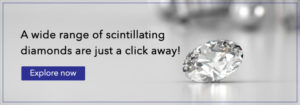Latest Technologies Used in Diamond Industry
Posted by Hari Krishna
January 29, 2022
Digital transformation is everywhere and the diamond industry isn’t an exception. With the advancement in technology, it becomes possible to mine, process, and sell diamonds online with ease.
On the other hand, with technology such as blockchain and AI, diamond businesses can have complete transparency that protects customers against unethical sourcing and unfair treads.
The industry has constantly evolved with time, thanks to innovative technologies. Let’s explore a few of them and how does it help the manufacturer and customers.
For any organization customer satisfaction and trust has a key role in achieving business success. Today, in the Diamond industry, it’s crucial to deliver high-quality products to survive in the competitive market. This can be achieved only through a high level of excellence.
Technological advancements have helped the diamond industry to reach new heights of excellence.
1. Synthetic Diamond Formation Technology
Previously the diamond industry where only dependent on natural diamonds but now with synthetic diamond formation technology, it is possible to create laboratory-grown diamonds.
We all know that the diamond is the purest form of carbon, to create a synthetic diamond all we need is the same natural condition that converts carbon into diamond. There are multiple methods to create synthetic diamonds but only two methods are widely used in commercial manufacturing.
• High Temperature and High Pressure
• Chemical Vapor Deposition
The lab-grown diamonds are chemically, physically, and optically identical to natural diamonds but can be differentiated by conducting spectroscopy, ultraviolet, and X-ray wavelength methods.
2. High-Frequency Seismic Reflection Technology
It’s challenging to determine the possibility of diamonds below the earth’s surface, even the experienced geologist can’t be sure about the location of diamonds.
Seismic reflection also known as Imaging technology is used to explore the possibility of diamonds beneath the earth’s crust. The technology is based on the principle that acoustic energy(sound waves) will bounce(reflect) of the interfaces between the layers inside the earth’s surface, which is similar to the human voice reflecting from the wall (echo).
The technology was previously used for detecting the warning signs of earthquakes, but due to its high potential, the technology is widely popular for the exploration of diamonds.
3. AI in Diamond Clarity Grading
Diamond clarity grading is highly important to keep the diamond quality at its best, otherwise, the diamond will lose its popularity among the buyers. This will result in a decline in sales.
Clarity grading assures the buyers about its quality. It specifies the essential details associated with the 4Cs of diamond to prevent possible fraud.
Artificial intelligence is also opening up new possibilities for diamond trade in the field of automated clarity grading.
In July 2020, GIA announced that it will collaborate with IBM to bring AI to diamond grading. AI and automated grading will enable onsite grading outside of the GIA laboratories for certain categories of diamonds.
4. Blockchain implementation in the diamond industry
The diamond industry has a broad consensus that needs transparency and blockchain technology is the best way to meet the requirement. Implementing blockchain in the diamond business can make a big impact.
The reason is, blockchain technology has a huge capability to bring the extent of transparency, which was missing before. Its main advantages are automation of documentation, ease of transacting online, and blockchain diamond tracking which will be secure, immutable, and transparent.
With the technology, the full lifecycle of the diamond from its origin to the last user will be recorded on the distributed ledger.
Blockchain implementation is a milestone step in defining the golden standard within the diamond industry, promoting transparency, and building trust.
Here we have discussed only a few technologies that are new in the diamond industry. However, the industry is huge, and to reach its best it will keep exploring new ways.
